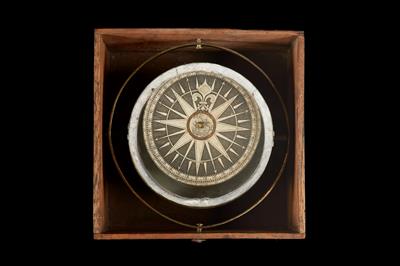Mariner's Compass
Download media
Object number01287
TitleMariner's Compass
Creator Jean Francois Hervouet (maker)
DescriptionThis mariner’s compass was made in France in 1764 by a French maker called Jean Francois Hervouet. If you look at the very centre you will see a beautifully illustrated, three-masted sailing ship. Vessels like this often had a much less attractive purpose in the 18th and early 19th centuries – they were used in the transatlantic slave trade.
The compass belonged to Captain James Forrest, who left Stirling to go to sea at an early age. He sailed ships from Alloa, Glasgow and Liverpool – in fact he married the daughter of a Liverpudlian ship owner. We know that in the late 1700s, when Forrest was sailing back and forth across the Atlantic, most ships linked to Liverpool were involved in the slave trade in some way.
It was a time of unrest on the high seas, which made things even worse for the enslaved passengers. Britain and France were at war: it was common for ships to be captured, renamed and put into use again. These prize ships were valuable – and captains like Forrest could make a fortune. He was able to retire to Stirling with his wife and family, providing them with a fine house and a stable income for life.
The plight of the enslaved Africans was miserable. On board, they were treated as cargo to be shipped from port to port. From 1514-1866 an estimated 12.5 million people suffered this fate. The names of most were never recorded. For most journeys, all that is known are the details of the route taken, and the name of the vessel and its captain.
Production placeVannes, France
Production date 1764
Object nameCompass
Materialoak
Dimensions
box Length: 293 mm
box Width: 290 mm
box Height: 195 mm
compass Diameter: 195 mm
box Width: 290 mm
box Height: 195 mm
compass Diameter: 195 mm


